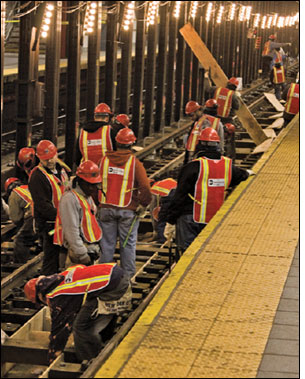In 2007, several subway operations fatalities occurred in the United States, prompting the U.S. Department of Transportation to push the industry to reduce hazards associated with maintenance and inspection work. Keith Sheardown, Bombardier‘s general manager of technology solutions for transportation, thought he could help. He had recently attended an RFID Journal event in Toronto, where he’d learned how British Petroleum had created a worker safety system, based on ultra-wideband (UWB) technology, to locate workers in real time. He thought the system could greatly reduce track worker fatalities.
Sheardown got approval to invest $100,000 to develop a UWB track safety system, but then he got cold feet. Would workers embrace the system or fear it would turn into Big Brother? Would the system be reliable? And would transit providers invest in it?

He decided to step back and examine how inspectors work and why accidents occur. Sheardown interviewed track inspectors and filmed how they do their job. He also bought a model train set and reenacted major incidents and fatalities that occurred in the United States over the past 10 years. Armed with this information, he worked with the McMaster University RFID Application Lab to develop a passive RFID system that creates a safety zone around workers as they walk along subway tracks.
“When we learned how track inspectors work, we realized that UWB wouldn’t be a good fit. What we needed to do was let a conductor know when workers were on the tracks ahead, and let workers know when a train was coming. As a result, we came up with a solution that will be more reliable, more effective and less expensive than the one I originally envisioned.”
The system, called TrackSafe, involves track workers wearing RFID tags. Passive RFID readers will be installed every 500 feet or so along subway tracks—the company is still determining whether high-frequency or ultrahigh-frequency will work better. The readers will be connected to a warning light and a speaker that emits an audible alert. When workers’ tags are read, lights along the track in both directions will be illuminated automatically to warn conductors to the workers’ presence, so they proceed with caution. And when a train enters the safety zone, the speakers will notify the workers of the oncoming train.
“Our software system will know where the workers are, the control center will know where they are, and when a train approaches the protect zone around them, the train operator will know where they are,” Sheardown says.
Currently, workers spend up to 30 percent of their time moving warning lights as they work along the track, but the lights are not always seen by conductors in time to avoid accidents. Sheardown says the new RFID system will improve safety and could reduce labor expenses by eliminating the time workers spend moving safety lights.
Bombardier will begin field-testing the system in August at its test track in Kingston, Ontario, in Canada. Sheardown believes that if all goes well, the company could begin deployment for customers by early next year.

